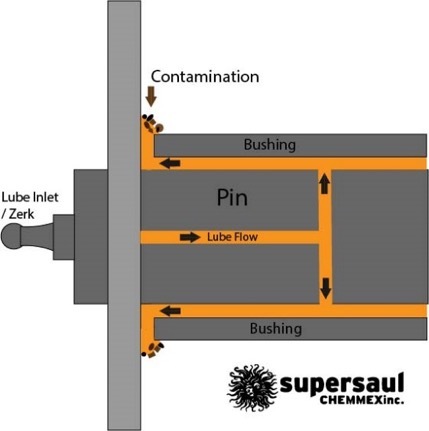
Features
Maintenance
Sawmilling
Saw and guide lubrication considerations
May 5, 2020 By Supersaul Chemmex
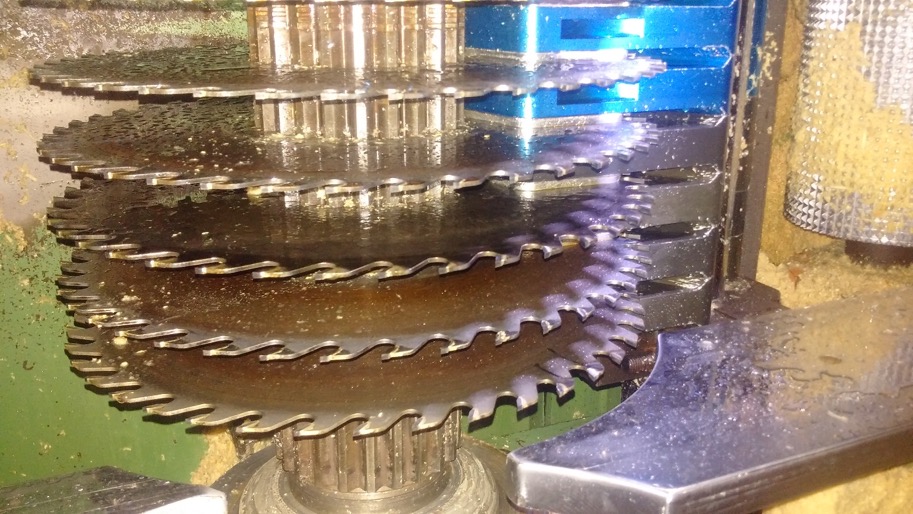 Photo courtesy Supersaul Chemmex.
Photo courtesy Supersaul Chemmex. When discussing lubrication there are five main things to always consider for your specific requirements:
- User friendliness
- Environmental impact
- Performance increases
- Cost
- Convenience
Below are some thoughts on saw guide lubrication. The following opinions are based on our extensive research and development, manufacturing and practical application of saw guide lube over the last 30 years.
With saw and guide lube there always seems to be two popular discussions:
- The use of tackifiers
- Water soluble versus water insoluble lubrication
Part 1
Tackifiers have many applications in our world from adhesives for tape to adhering ingredients together during the manufacturing of tires or adhering lubricant to itself to prevent misting in the air during industrial processes. Tackifiers are designed to prevent the flow of liquids.
Lubricant tackifier history
Increasing lubricant viscosity is a way of preventing two surfaces under increased load from touching.
Before the 1920s, base oils of various kinds (mineral, plant and animal oils) were sufficient to lubricate machinery. Tackifiers got their start in lubricants somewhere in the late 1920s or early 1930s as a grease additive to hold lube in place. At the time, it was a breakthrough and a solution. In applications that do not require quick heat transfer, tackifiers are a great addition.
Lubricant tackifiers are very long chain polymers that are soluble in oil. Tackifiers were introduced as a way to increase viscosity under load (cohesion) as well as keep the lubricant attached to the wear surfaces (adhesion). A tackifier helps keep the grease in place and prevents it from running out. But when tackifiers are exposed to high shear environments, they break down.
Lubricant tackifiers still see use in the modern age in greases, open chain, open gear and bar oils. But how are they used in saw and guide applications?
Tackifiers in saw and guide applications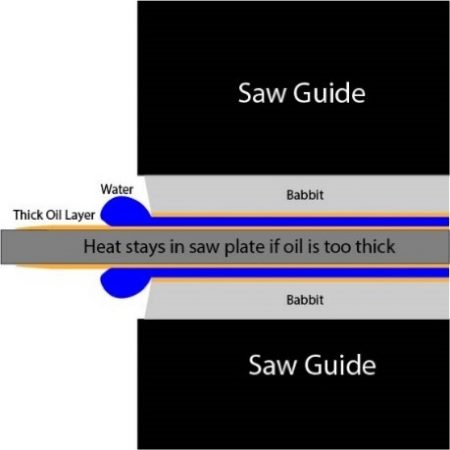
Tackifiers’ adhesion and cohesion characteristics keep oil where you want it, which can be beneficial in the right applications. A tackifier’s cohesion properties prevents lubricant from flowing quickly and under high-speed, tight tolerance situations – such as in modern saw guide clearances – this can also create friction, which creates heat.
Tackifiers’ natural tendency to keep an oil in place also results in a thicker oil film. There is a flip side to this, though. A thicker oil film creates slower heat transfer. In a saw guide application, a thick oil film acts as an insulator. Saw filers know all too well that saws require quick heat transfer and do not tolerate much heat buildup. Quality lubrication does not require high volumes when the right lubricant is selected. The right lubricant will lower friction with a minimal oil layer.
Considerations for selecting lubricant
Some mills use the same lubricant for chain oil as they do for the saw
box. Tackifiers’ adhesion and cohesion attributes in practical use allow contaminates to attract and not be released from the lubricating oil. This can promote extra wear by holding contaminants in the lubrication area, which is ideal in applications that are lubricated from the inside towards the outside. For example, greasing a bushing.
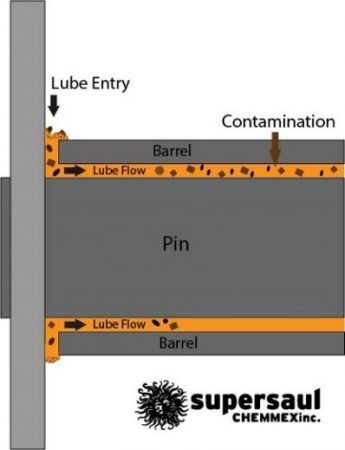 In applications that are lubricated from the outside in, tackifiers can help draw more contaminates inside.
In applications that are lubricated from the outside in, tackifiers can help draw more contaminates inside.
An example of this is lubricating a roller chain
Another thing to keep in mind is that the addition of tackifiers in a lubricant usually results in poorer cold weather flowability. Tackifiers are designed to prevent flow.
Ultimately, tackifiers have their place in the lubrication industry. However, in high speed/ sliding, close tolerance and or highly-contaminated areas such as saw guides, there are other options available to consider for improving your performance.
Part 2: Water soluble lubrication
Having a low shear strength and molecular thick film at the precise point of contact between two surfaces can reduce friction.
Unlike tackifiers used in saw and guide applications, which are simple polymers repeated many times (100,000 – 200,000 chain links long), water soluble lubrication has very complex chemistry. It requires forcing liquids that do not naturally want to mix to mix (immiscible liquids). This solution is known as an emulsion.
Water soluble lubrication is common in the metal-working industry and has been discussed as a potential way of lubricating saws and guides for decades. Fun fact: this chemistry is not just popular in metal-working lubrication, but various cosmetics and moisturizing creams also use it.
In the forest industry you may already be familiar with various emulsions in your workplace, from your mill’s machine shop to press release lubricants in panel plants, as well as wax coatings applied to LVL and on the ends of high-spec lumber products.
With water soluble lubricants, there are two basic routes.
Oil in water and water in oil.
- Oil in water works by encapsulating tiny droplets of oil in a surfactant that then float suspended within water.
- Water in oil works by encapsulating water, which is held in suspension in oil or solvent. (This is intentional water in oil – not to be confused with water contamination of conventional oil.)
Oil in water can be broken down into three more generalized variations:
Emulsions (soluble oils) – These are cloudy in appearance, as suspended droplets are big enough to refract light. These are unstable mixtures that can easily separate.
Micro-emulsions (semi-synthetics) – These are clear in appearance and are very stable mixtures that contain less oil than emulsions.
Micelles (synthetics) – These don’t use oil and instead use surfactants as the lubricant.
Important considerations for your saws and guides:
Water soluble lubrication is characterized by high cooling, low lubrication. This type of lubrication utilizes boundary lubrication principles. Water does the cooling and the oil (or surfactant) in suspension does the lubrication.
Boundary lubrication requires the surfaces to touch and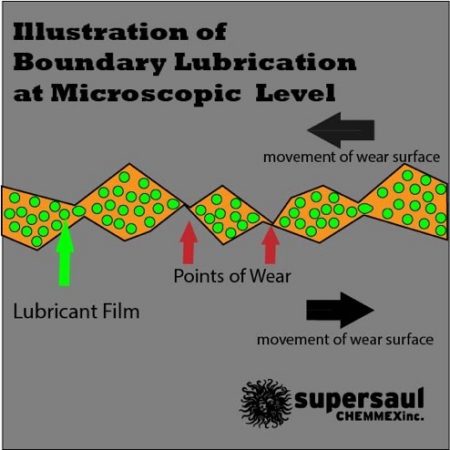 then reduces the friction and wear at point of contact. This does not prevent wear. In fact, conventional boundary lubrication school of thought fully expects there will be surface-to-surface wear. Most components for boundary lubrication are designed to function in extreme pressures and or slow-moving environments.
then reduces the friction and wear at point of contact. This does not prevent wear. In fact, conventional boundary lubrication school of thought fully expects there will be surface-to-surface wear. Most components for boundary lubrication are designed to function in extreme pressures and or slow-moving environments.
Wear happens when deviations in the surfaces hit each other. When this happens, pieces can break off or adhere to the other wear surface.
In lubricating oil chemistry, boundary lubrication is your last defense before complete contact between surfaces. In water soluble lubrication, boundary lubrication is generally your main defense against wear.
Boundary lubrication additives work by interacting with the metal surfaces. Most of these components have been developed with ferrous metal in mind, like steel and cast iron. When it comes to saws and guides, you have a ferrous metal and non-ferrous metal interacting (such as a steel saw plate and babbitt guide).
In industry, due to the nature of the additives in water soluble lubrication, they are generally used in closed lubrication systems. In a once-through system, like saws and guides, every litre of water needs this lubricant mixed in the water, whether it contacts wear surfaces or not.
From a disposal point of view these types of lubricants pose extra challenges, which can be especially difficult with micro-emulsions because they are very stable. If released into the environment, the emulsion can be carried into any place that water can travel or absorb into. This includes all the additives in the lubricant, such as rust inhibitors, biocides and lubrication additives.
Conclusion
Water soluble lubrication and the use of tackifiers have their merits and uses in industry. However, for saw and guide applications are they really the right choice? It is okay to question old ideas on lubrication when the demands placed on your saws are ever progressing. The above conclusions are a result of our extensive research, development, manufacturing and practical application of saw guide lubricant over the last 30 years.
The article is part of our 2020 #FileWeek coverage. Read more here.
Print this page
